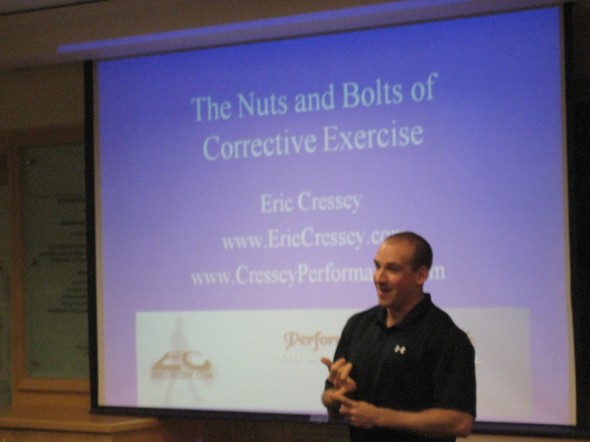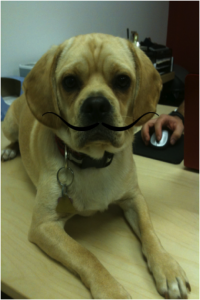 Eric Cressey has been a good friend of mine dating back to 2003 when we first started conversing and writing together for T-Nation.
Eric Cressey has been a good friend of mine dating back to 2003 when we first started conversing and writing together for T-Nation.
Whether you’re an athlete, avid weight trainer, or just someone who wants to learn more about the human body, you could do a lot worse than listening to Eric.
Here’s a brief interview we did that I think you’ll enjoy!
MR: I’m not going to have you introduce yourself, because you’ve been featured on the blog at least a half-dozen times now. What’s new in the world of Eric Cressey? Isn’t the off-season program kicking off around CP about now?
EC: Yes, we’re in full swing – and actually have been for quite some time now. We have minor league guys who literally start up the day after the season ends, so our first pro guy was back training at Cressey Performance on September 6.
When all is said and done, we’ll have over 70 professional baseball players training here this off-season; in fact, we have guys from 29 of the 30 teams (let’s just say that I don’t pick the Angels to win the AL West in 2012 for that reason).
MR: Baseball is your thing, and you’re always learning about it. Give me a thing or two you’ve learned or realized about training baseball players over the past year or two. Anything changed or refined?
EC: I’ll give you a shoulder and a hip example.
#1 – We’ve always thought that the overwhelming majority of guys who had glenohumeral internal rotation deficits simply needed a lot of stretching for the posterior rotator cuff. In reality – especially in right handed pitchers – we’re doing more positional breathing (as per the Postural Restoration Institute philosophy) to get that range of motion back (guys have faulty scapular positioning secondary to left rib flairs and more left than right thoracic rotation).
It doesn’t work with everyone, but when it does, it’s a slam dunk, as it means that you don’t have to stretch a delicate joint like the shoulder nearly as much. That said, most guys that aren’t really congenitally lax do still need some gentle stretching for the posterior shoulder.
#2 – I’ve learned so much about the interaction of the anterior core, pelvic, and adductors. Femoroacetabular impingement, sports hernias, and labral injuries are so prevalent nowadays that it’s essential that we understand these issues. If I had to dumb things down, I’d say that the anterior core is losing a tug-o-war over the pelvis to the adductors, and the issues are manifested at the adductor aponeurosis on the anterior aspect of the pubis, where the inferior attachment point of the rectus abdominus interacts with the superior attachment point of the adductor longus. Good luck foam rolling that – and be sure to wash your hands if you try manual therapy in that region.
Along those same lines, remember that the imbalances in the anterior core are significant as well. If external obliques are weak, rectus abdominus picks up the slack. That generates kyphosis via a downward pull in the rib cage, but more significantly, remember that the attachment point of the rectus abdominus on the pubis is only 1/3 as large as the attachment point on the inferior rib cage. Which end do you think is going to go first?
MR: You’ve also alluded to how your own training has changed a bit over the years. Care to expand on that?
EC: I’m 30 years old and balding, so I mostly just lift to make sure that I still have bragging rights atop the Cressey Performance staff leaderboard. Kidding…sort of.
Actually, I’m still lifting heavy on a regular basis and having a lot of fun with it. Honestly, as lame as it might sound, staying athletic is tremendously important for me. Baseball players can’t stand strength coaches who act like football strength coaches, and looking the part is somewhat important in that regard. I actually wonder if I would be as effective at my job if I was 240 pounds and 18% body fat (read: bowling ball) instead of being 190 pounds and lean with a 37” vertical jump.
I’d like to think so, but I don’t plan on finding out.
MR: You recently re-launched your incredibly popular product, “Show and Go.” Who is this program geared towards? Or better yet, who would benefit from it?
EC: Before Show and Go was ever released, I put a big group of male and female “guinea pigs” through the program with some outstanding results. It wasn’t uncommon to see increases of 80 pounds and more on the squat and deadlift, with improvements about half those amounts on bench pressing and chin-up totals (understandably smaller, given the smaller window of adaptation for upper body strength). We had people drop more than 25 pounds and 5% body fat while on the program, and we had scrawny guys who gained as much as 24 pounds in the four months. It came down to what their starting goals were, and how they attacked things nutritionally on the side.
We even had many athletes who used this program in conjunction with their sports training – from endurance competitors to rugby players – with excellent improvements.
The cool thing is that literally every single one of these “guinea pigs” made a point of noting how much better they felt; they improved mobility and moved more fluently by the end of the program. This is a stark contrast to the aches and pains you normally see with programs geared toward performance improvements; the program not only improved performance and made people bigger, stronger, and leaner; it also helped set the stage for healthy future training.
MR: What are two or three things that you consistently see people do wrong when they write their own programs (versus following one written by an expert or coach)?
1. They usually do what they enjoy doing, not what they truly need to do.
2. They either deviate too far toward the “corrective exercise” or “just lift heavy stuff” end of the spectrum, as opposed to finding a happy medium.
3. They don’t stick with it. When you write the program, you won’t hold yourself accountable; that’s just human nature. If someone else writes it, you’re far more likely to follow through. This is actually true in a wide variety of situations in society where we outsource tasks – from hiring a cleaning service (could clean your own house/office), to paying the kid next door to shovel your steps in the winter, to using an accountant at tax time. Training should be no different.
MR: Last but not least – if someone is sitting on the fence about buying Show and Go, how would you convince them to buy a copy TODAY?
EC: I’d enclose a photo of my dog…with a mustache. You can never play the cute card too hard. A portion of each sale will go to purchasing this puppy toys – and a mustache grooming.
 Joking aside, I would just remind people that you are only given one body – so this isn’t a test drive. If you’re going to trust someone else with it, make sure you trust someone who has the experience from which he/she can gain the perspective to make your programs safe and effective.
Joking aside, I would just remind people that you are only given one body – so this isn’t a test drive. If you’re going to trust someone else with it, make sure you trust someone who has the experience from which he/she can gain the perspective to make your programs safe and effective.
MR: Awesome man. Thanks again for taking the time to chat!
In case you guys missed it, Show and Go is on sale this week ONLY for 50% off! And if you actually take action, I’ve created a special contest where you can win free stuff as well. Just follow the link below to find out all the details!
==> Show and Go – 50% off AND Special Bonus Prizes! <==
All the best
MR
